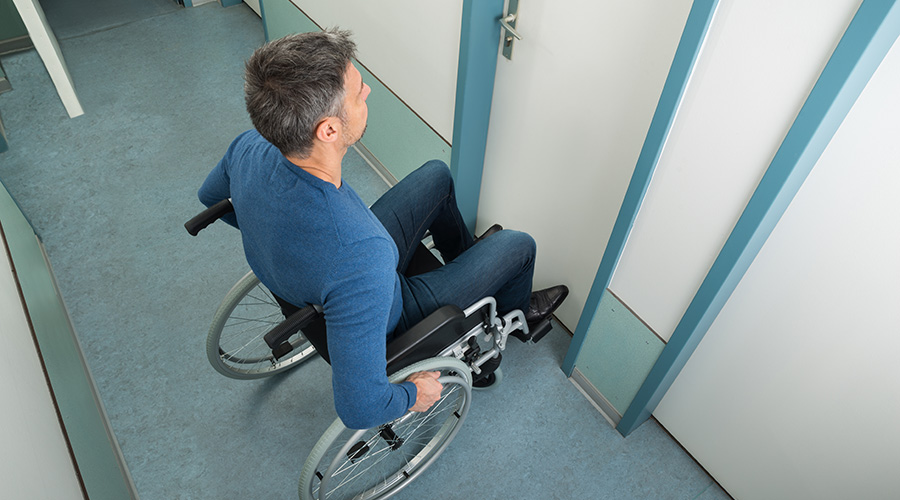ADA Guidelines: A New Generation
Streamlined and fine-tuned guidelines from the Access Board present managers with challenges in improving accessibility
The Access Board’s publication of new facilities access guidelines under the Americans with Disabilities Act (ADA) raises a host of new questions for maintenance and engineering managers. Are the new guidelines the same guidelines that made headlines a few years ago? What are the major changes affecting particular institutional and commercial facilities? Are the new guidelines final? If not, what is the next step in the adoption process?
Trying to stay on top of and understand these new accessibility guidelines can be both challenging and confusing, but it is essential in ensuring compliance and making facilities more accessible for people with disabilities and more comfortable for all occupants and visitors.
Streamlining Guidelines
The new ADA accessibility guidelines (ADAAG) were developed to implement the ADA and the Architectural Barrier Act in order to meet the estimated needs of 54 million individuals with disabilities.
The guidelines update the current access requirements for public and private sectors, but are they final and usable? After a lengthy and comprehensive process, the guidelines are closer to becoming final standards. The new guidelines now must go through a three-step process by the U.S. Department of Justice (DOJ) to be final and enforceable. The good news is that the regulatory process will allow public input on a variety of questions that will affect both the content and timing of the guidelines.
Depending upon the results of this process, revisions of the new guidelines will result in a number of important changes affecting educational, medical, government and commercial facilities that managers should be aware of.
The new guidelines serve as a framework or baseline for standards that will be developed by other federal agencies, including the DOJ and the U.S. Department of Transportation. It is these standards, not the Access Board’s guidelines, that the public will have to follow.
For more on the process the guidelines face on the way to becoming standards, see the sidebar.
A Range of Changes
The review and update of ADAAG represent a greater harmonization of building codes, the use of new technology and improved access to meet the needs of individuals with disabilities. The guidelines address access in new construction and alterations, and they contain scoping provisions that describe areas of facilities that must comply, in addition to technical specifications that spell out compliance guidelines.
Overall revisions include a new format and numbering system, streamlined chapter structure and organization, updated scoping and technical provisions, new figures and advisory information, greater consistency with model building codes and industry standards, clarification of construction and manufacturing tolerances, and the replacement of some absolute standards with ranges.
The area of plumbing offers one example of where ranges of dimensions have replace absolute specifications. The current ADA standards require that toilets in accessible stalls be centered 18 inches from the sidewall or partition. The new ADA guidelines allow for a range of 16-18 inches for accessible stalls and 17-19 inches for ambulatory accessible stalls.
Some ranges have been reduced, such as the change from a maximum side reach range from 54 inches in the current standard to 48 inches in the new guidelines. Other ranges, such as those for handrails, will permit a greater range of designs and shapes.
Opportunities for Input
To highlight a few of the changes and to provide an opportunity to provide input into the advanced notice of proposed rulemaking (ANPRM) published by the DOJ, the actual question number in the ANPRM will be referenced along with the area and question for which the Department of Justice is seeking input. The following eight questions are examples of areas in which the department seeks input:
Effective date. The DOJ is seeking input from interested stakeholders regarding three options for the effective date of the new standards; 18 months, 12 months or six months after publication of a final rule.
Existing facilities and safe harbor. One of the most important areas that the DOJ will consider is the effect new or changed ADA standards will have on the public accommodations to remove barriers in existing facilities. The DOJ is concerned that changes in the new standards might place significant cost burdens on businesses that already are in compliance with the current ADA standards in their existing facilities. The department is seeking input on whether or not to provide a safe harbor for design elements that comply with the current ADA standards and has provided several options to reduce the financial burdens on businesses. An option is to establish a “safe harbor” that would help businesses comply and reduce costs.
One approach is to establish a safe harbor for businesses that worked to achieve or are in compliance with the current standards and would not be required to comply with the revised ADA Standards if the change provides only a minimal improvement in accessibility. Another option is to reduce the scoping for specific requirements, and the third option is for an exemption from specified requirements.
Toilet rooms, question 14. Under current ADA standards, men’s toilet rooms with six or more water closets and urinals but fewer than six toilet compartments are not required to provide an ambulatory accessible toilet compartment with grab bars. Under the new ADAAG 213.1, urinals will be counted. If there are a total of six urinals or water closets, the new ADAAG will require an ambulatory accessible toilet compartment with grab bars.
Public TTY, question 15. The current standards require a private office building to provide a TTY if there are four or more public pay telephones in the building. The new standards will require a public TTY on each floor that has four or more public telephones and in each telephone bank that has four or more telephones.
Hotel guest rooms, question 19. A new standard, ADAAG 806.2.4.1, requires a comparable vanity space in an accessible hotel guest room if one is provided in a nonaccesssible hotel guest toilet.
Hospital and long-term-care facilities, question 26. ADAAG 607.6, a new requirement, requires that the shower spray unit in an accessible shower compartment must have an on-off switch.
Recreation facilities, question 42. The new ADA requirement provides that every new or altered amusement ride must provide at least one wheelchair space or transfer seat or transfer device. The current recreation facilities guidelines allow the transfer device to be separate from the ride.
Recreation facilities question 42. A new swimming pool whose perimeter is over 300 linear feet will be required to have at least two accessible means of entry under the new ADA standards. At least one of the entry points must be a lift or a sloped entry.
It is important for managers to provide input and keep an eye on the standards that will be set by the DOJ because major changes might occur to the new guidelines. Also, options for safe-harbor situations might evolve as the guidelines go through the process to become standards.
Barbara Thorpe is president of Disability Access Consultants Inc. a national accessibility consulting firm.
The Guidelines: What Lies Ahead
After a decade-long process, stakeholder collaboration and extensive input, the Access Board released new accessible-design guidelines in July 2004. In September 2004, the new guidelines became effective as guidance for the ADA standard-setting agencies.
Publication of the new ADA guidelines represents a significant accomplishment, but a published final rule from the U.S. Department of Justice (DOJ) is far from complete. The regulatory process must occur before the DOJ publishes a final rule in its capacity as the enforcement agency. Until the new guidelines become standards, the current ADA accessibility guidelines (ADAAG) published in 1991 remain in effect.
It is difficult to predict when the guidelines will become standards and will be enforceable. Final standards might be a year or two away, depending upon public input and the regulatory process.
Following the publication of the new ADA guidelines, each standard-setting agency must publish enforceable regulations that include design standards consistent with the guidelines. ADA requires that the DOJ publish regulations that include accessibility standards consistent with the Access Board guidelines. So the board’s guidelines have no legal effect on the public until standard-setting agencies have completed their rulemaking process. The public must follow the standards maintained by the DOJ under the ADA, not the board’s guidelines.
The department has initiated its rule-making process with the publication of the advanced notice of proposed rulemaking (ANPRM). As a required first step, the ANPRM is intended to solicit public input regarding the revisions to the current ADA standards. Comments will be accepted until Jan. 28, 2005.
The second step will be a notice of proposed rulemaking, followed by publication of a final rule. The DOJ also will have to complete a benefit-cost analysis to further determine the effects of the proposed new guidelines.
BACK TO ARTICLE
|
Related Topics:











